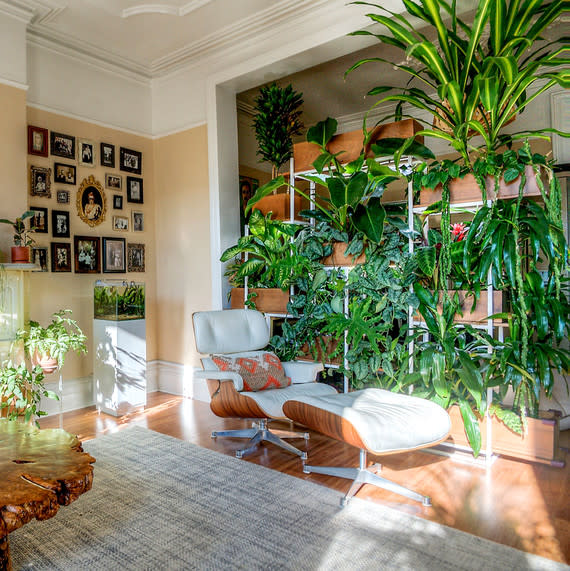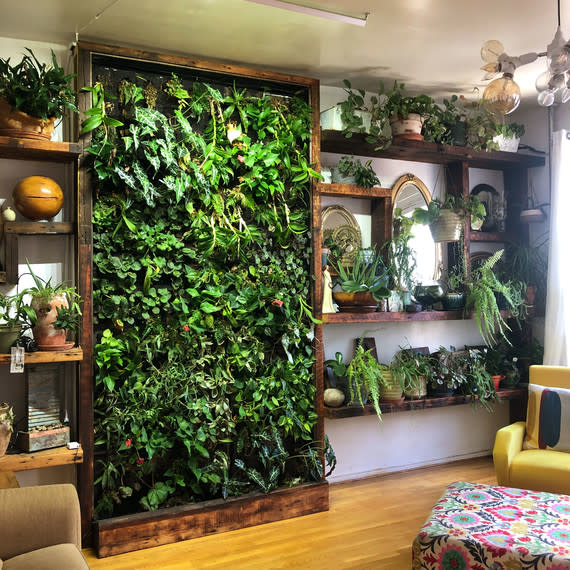Vertical Gardens Are the Perfect Small Space Solution for Plant Lovers

Nothing beats plants when it comes to adding depth, color, and life to a room. If you’re living in a small home, though, you don’t need to sacrifice greenery for floor space thanks to a vertical garden. Here’s how to get started.
What is a Vertical Garden
Vertical gardening is the art of using vertical space to grow and display plants, whether that’s finding the right mix of containers, shelves, and hooks to hold your collection, or installing a full-scale living wall. “One of the benefits of living walls is that they allow us to incorporate an abundance of plants inside without things getting too crowded,” says Rebecca Bullene, the founder of Greenery NYC, a garden design firm in New York City. “Living walls typically will have hundreds of plants in them—it would take up too much room to put those on the floor, you'd have nowhere to walk!” Another bonus: plant installations double as dramatic living art on the walls.
Related: Learn More About the Benefits of Living Walls
Find the Right Spot in Your Home
To get started, assess your space to locate the right areas for plants. This also depends on the type of plant and what conditions it requires. “[For most plants] ideal locations are walls near windows that get ample sunlight,” says Bullene. This means at least three to six hours a day for decorative plants, and six to eight hours for edible plants. Make sure to choose a place that’s accessible, though, since most plants need water weekly—if they’re hung too high they’ll be difficult to maintain.

Choose Your Plants
The next step is to choose your plants. When you’re at your garden center, farmer’s market or local plant shop, don’t be afraid to ask questions about what will work in your space. “In terms of decor, there are many plants to choose from,” says Gennaro Brooks-Church, founder of green building company Eco Brooklyn Living Walls, who installed an impressive living wall on the entire facade of his New York City townhouse . “In terms of edible plants, the options are more limited. Many vegetables need a deep root system to thrive, something that isn't always possible on a wall.” But there are still options you can try: Crops that do well are leafy greens like lettuce or spinach, herbs and small fruits like cherry tomatoes and strawberries. Bullene also recommends using grow lights if your goal is more of a kitchen garden: “Some of my favorite herbs to grow inside are mint, parsley, and rosemary,” she says.
Related: Learn How to Plant a Vegetable Garden
Pick the Right Set-Up
In addition to finding plants that will thrive in your home, make sure you choose vessels that are right for your plants. Maintaining moisture levels in your plants can be made harder or easier depending on your container. For living walls, Brooks-Church says, “you need to have a growing medium that holds enough water so the plants don't dry out, but doesn't hold too much water so the plants drown.” Some great options are plant trays, trellises, hanging planters, and even shoe organizers. If you're hanging your vertical garden indoors, make sure to avoid putting plants over radiators. “They dry out too quickly with heat hitting the roots,” says Bullene. She recommends using sub-irrigated planters, like this one from Lucy Kaas, when possible to allow your plants to drink from a water reservoir at the bottom of the pot, which cuts down on watering time.
Vertical Gardens Work Both Indoors and Outdoors
“Anyone can grow vertically indoors” says Bullene. “Vertical gardening outdoors is harder in colder climates only because plants generally will perish over the cold weather months.” But the expert grows lots of veggies on walls and fences in New York, and just resign herself to the fact that they are annuals that will need to be replanted each spring. For those lucky enough to be in Zone 7 and up, (find your zone here!) the sky is really the limit in terms of what they can grow vertically outdoors. And for apartment gardeners, it’s almost certainly worth a try. “Indoors there are no limitations to vertical gardening,” says Brooks-Church. “You create the ideal conditions.”
Need more inspiration: Watch Martha and Marc Hachadourian create a vertical garden with ferns and orchids in the video below.

